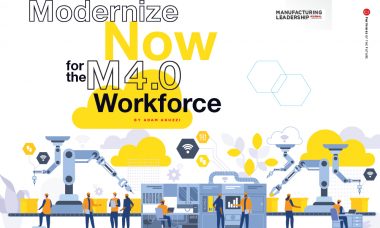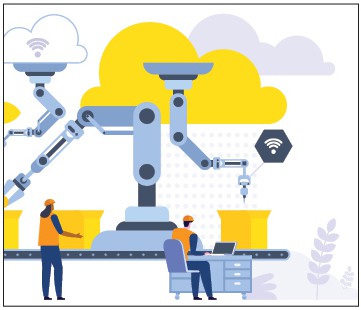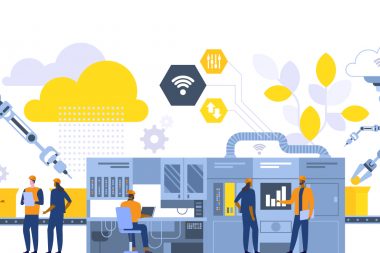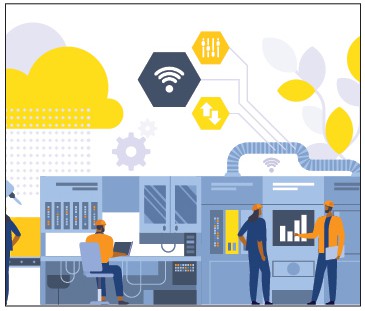
Factories of the future cannot be powered by the workforce of the past.
By Adam Aguzzi

The manufacturing sector emerged as an unexpected bright spot amidst the fog of disruption brought on by the global pandemic. As demand rose for the crucial PPE required for the medical community and frontline workers, many manufacturers quickly shifted their operations to produce the equipment needed.
While this agile response was essential to survival in 2020, it also has accelerated the broader need for digital transformation in the sector. In the wake of COVID-19, timelines to digitize manufacturing have been compressed from five-to-10 years to a two- to three-year window. As we look to a future defined by continued rapid change, the sector needs to harness learnings from this past year and embed a technology-first operating model into its DNA.
Enter the long-awaited “smart factory” or “factory of the future.” Deloitte defines it as “a leap forward from more traditional automation to a fully connected and flexible system — one that can use a constant stream of data from connected operations and production systems to learn and adapt to new demands.” Research has clearly demonstrated the power of such an evolution, pointing to improvements in many key categories, including cost, safety, and growth; driven by modern tech like AI, machine learning, and cloud computing.
However, making smart factories the industry standard will require a significant amount of focus on modernization of a workforce that is often still powered by outdated strategies and technology that relies on batch-based processes. While the industrial internet of things has already made available much of the technology infrastructure needed, decisionmakers will need to simultaneously accelerate the integration of modern workforce technologies and principles in order to compete.
Here are a few areas of focus for the sector that are now the standard in the future of work:
Integrated HCM Systems
Many manufacturers are working with human capital management (HCM) systems that have been cobbled together over the years, combining disconnected upgrades to ERPs, HR platforms, and a host of specialized third-party modules. This fragmented collection of often incompatible software is duct-taped together through spreadsheets that act as bandages wherever holes are discovered. Unfortunately, this combination does not add up to a forward-facing technology stack that can manage the workforce effectively in a rapidly changing world. The technical debt borne of this approach will get in the way of manufacturers’ efforts to pivot quickly, adapt to new market opportunities, attract the best people, and find efficiencies in production and labor planning.
Instead, companies should unify their workforce systems as much as possible through a rigorous program of digital transformation. This approach allows for the agility and intelligence needed to support the workforce better right now, while also helping them identify and overcome the “unknown unknowns” that will inevitably emerge as manufacturers navigate the period of prolonged uncertainty in front of them. While many organizations are focusing their digital transformation efforts on the mechanics of the factory floor, a true “factory of the future” — hyper-connected and automated for maximum efficiency — must include upgrading the systems that fuel and support their people, while ensuring workforce data leads to actionable insights.

“Improving the tech readiness of manufacturing means not only having the right technology on the production floor, but also having the right people and skills in place to drive the most value from it.”
It’s a constant balancing act to connect the dots between the production crew’s skills and the needs of the production floor. Pulling on workers’ abilities, talents, and skills requires an HCM system that is constantly updated with a robust skills matrix that reflects the evolving strength of the production crew. The systems many manufacturers currently have in place are already struggling to address the complexity of workforce management and labor planning today, and that gap will grow even greater in a year, during the next crisis, or the next time the organization faces a shift in the production mix.
The HCM solution that will achieve the balance between labor demands and skill makeup is one that is integrated between HR, production, training, and recruitment. Providing a common database that powers data-driven decision-making across the organization for a holistic approach to maximizing production line performance. It requires a workforce management (WFM) system that is flexible, while also demanding a single source of truth on which to base decisions. The benefits from this integration include reducing unplanned overtime, which often is mismanaged in the absence of illustrative tools managers can use to make changes in real time.
Lack of integration can also have legal consequences if errors occur between pay issued and actual hours worked due to disconnected time and pay systems, resulting in under or over payments to employees. Compliance with a host of intersecting subsidies, internal policies, tax requirements, and legal obligations is increasingly complicated because of the pandemic. At present, extensive auditing is required to ensure a minimum level of compliance. Auditing is often designed to correct errors that companies know occur, not to identify and proactively correct broader process and issues and systemic challenges. Working from a single source of data across all HCM systems allows for a higher degree of confidence that the data is right the first time, while reducing the prevalence of errors.
Manufacturers’ future competitiveness will come down, in part, to how these systems are used to promote organizational agility. The right platform will allow companies to design a steady, targeted training plan that prepares their crews for the production environment in one to five years, not just to meet the demands of right now. This includes upgrading workers’ skills to transition them to new positions and build technical expertise based on the long-term production and strategic plan.

On-Demand Pay
Employees are facing an increased level of financial stress during the pandemic. Companies need to invest in innovations that make the employee experience more intelligent and on demand — and doing so can become a competitive advantage for attracting and retaining top talent. This would entail giving employees access to funds that they have earned right away, rather than making them wait for funds to be deposited at the end of the traditional pay period. During COVID, many young workers have also found themselves needing to accept short-term gig assignments, which, while temporary, offer instantaneous payment for their time. It will likely be important to create a more seamless transition between gig work and traditional employment as the nature of work continues to evolve — and from a pay perspective, it could mean the difference between a great employee accepting an offer with your organization or going elsewhere.
Over the next five years — let alone 10 years — the high vacancy rate in manufacturing will become a significant barrier to maintaining the right numbers of workers and skills to operate. Even though upgrading skillsets will help keep employees relevant, the lack of interest in manufacturing by young workers will mean that even at accelerated rates of automation there simply will not be enough people to make the parts, food, and technologies needed by American manufacturers. Currently only 49% of millennials believe manufacturing provides fulfilling careers (2019 L2L Manufacturing Index). In the hyper-competitive labor market we’re facing, every convenience and consideration embedded in the employee experience will matter. Harvard Kennedy School’s research evaluating the impact on blue collar workers when offered equivalent credit/liquidity capabilities, like on-demand pay, resulted in turnover improvements of 19%.
On-demand payment can improve retention and reduce absenteeism by allowing workers to handle unexpected life challenges without having to rely on credit cards and pay-day loans. For example, consider the case of an unexpected car breakdown, which carries an average bill of $400. As most factories are outside the city, employees need a car to get to work. As young workers typically have less financial stability, they may not be able to afford to pay for the repair and return to work. With on-demand pay, however, they can access their earned wages and pay for the car repair right away. The technology is available now: It’s simply a matter of prioritizing the digital transformation of payroll and WFM systems to allow these tools to drive improvements for everyone.
Intelligent HCM
Without insights from data to drive decisions, a company is flying blind, unable to understand their baselines and the true impact of their improvement initiatives. Most companies lack the robust, intertwined data from manufacturing and HR to power the necessary level of business intelligence. There are pockets of data available, but these don’t suffice in creating dynamic benchmarks and improvement metrics needed to compete against companies that have undergone deep digital transformation.

“Prioritizing the workforce in every digital transformation project is no longer a nice-to-have, but a standard component that cannot be ignored.”
It’s often the case that companies rely on spreadsheets, manually populated from paper tracking sheets, to understand production performance. That same lack of a strong data pipeline limits the company as a whole from understanding how production and information flow between departments.
There is little point in trying to compete in the next five years if a company’s business intelligence is limited to a hand full of boiler plate metrics, like units produced and number of people on the line. True performance gains will likely come from a having a business intelligence system that allows the investigation of production limitations.
Deeper insights need to be more intelligently focused on cross-functional metrics to understand the interconnectedness of labor initiatives:
- Tracking training effectiveness between learning systems and job performance requires coordination between “classroom” training and practical, hands-on training. If gaps exist in the strategy, or even just timing, between the two, the training program may amount to wasted time as learning needs to be reinforced to be retained. On the surface, simply checking that the training has been done is what many companies do. But true training needs to be tracked, measured, and fed back into a continuous improvement loop to be successful.
- Lagging skills need to be identified by aligning the product mix, and upcoming product releases, with the skills matrix of the labor pool. Simply deciding that the crew can adapt on the fly only sets a company up for increase failures, scrap, and efficiency losses. Understanding the amount, and makeup of labor when determining production plans requires a WFM system connected to the learning and HR records.
- Labor fluctuations vary among product mix due to the complexity of assembly. However, planning properly for those fluctuations beyond the current week is often beyond the capabilities of manufacturers’ WFM systems. The need to meet labor requirements months from now is a lesson that seasonal industries have already learned. However, getting the labor volume correct is only part of the equation. Specific skills highlighted during recruitment need to be determined months ahead, so that temp or permanent labor can be built into budgeting plans. In the future, gut feelings and tribal knowledge will no longer be enough to make these crewing decisions.
Attracting the Right Talent at the Right Time
At the end of the day, improving the tech readiness of manufacturing means not only having the right technology on the production floor, but also having the right people and skills in place to drive the most value from it. As we enter 2021, the future of manufacturing will hinge on the sector placing a renewed focus on employee engagement and experiences that will attract and retain the right talent at the right time. As labor typically represents the second largest expense for most manufacturers, prioritizing the workforce in every digital transformation project is no longer a nice-to-have, but a standard component that cannot be ignored. Because while the factory of the future brings much promise to the sector, it won’t become a reality if it’s being run by the workforce of the past. M